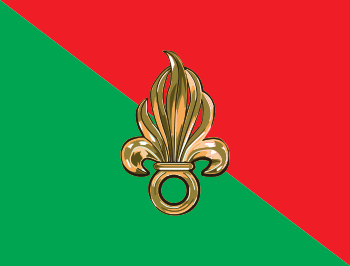Marching Regiment of the Foreign Legion
| Marching Regiment of the Foreign Legion Régiment de Marche de la Légion Etrangère | |
|---|---|
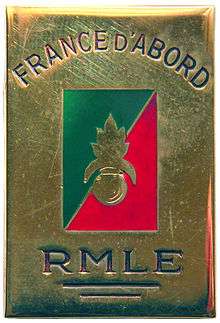 Insignia of the R.M.L.E | |
| Active |
Marching Regiment of the Foreign Legion
|
| Country |
|
| Allegiance |
|
| Branch | French Army |
| Type | Infantry |
| Size | 2700 men |
| Motto(s) | France d'abord ("France, first") |
| Colors | Green and Red |
| Anniversaries | Camerone (April 30) |
| Engagements | |
| Commanders | |
| Notable commanders | Paul-Frédéric Rollet |
| Insignia | |
| Abbreviation | R.M.L.E |
The Marching Regiment of the Foreign Legion (French: Régiment de marche de la Légion étrangère, R.M.L.E) was a French military unit of the French Foreign Legion which fought throughout the course of World War I and World War II, initially composed from various Marching Regiments of the 1st Foreign Regiment (1erR.E) of Sidi Bel Abbès, 2nd Foreign Regiment (2eR.E) of Saida, Algeria and reformed under various designations to form the 3rd Foreign Infantry Regiment (3eR.E.I).
The Marching Regiment of the Foreign Legion was created on November 11, 1915 by merger of the 2nd Marching Regiment of the 1st Foreign Regiment, (French: 2e Régiment de Marche du 1er Régiment Etranger, 2eR.M.1erR.E) and the 2nd Marching Regiment of the 2nd Foreign Regiment, (French: 1er Régiment de Marche du 2e Régiment Etranger, 1erR.M.2eR.E) while counting 71 Officers, 3,315 Sous-Officiers, Caporaux and Legionnaires.
The Marching Regiment was subsequently the first Regiment of the French Army to bear wearing the fourragere with colors of the Médaille militaire and one of the most decorated along with the Régiment d'infanterie-chars de marine (R.I.C.M).
Creation and different nominations
- On November 11, 1915: the Marching Regiment of the Foreign Legion, (R.M.L.E) was created from merging mainly the remaining men of the 2nd Marching Regiment of the 1st Foreign Regiment, (2eR.M.1erR.E.) with the 2nd Marching Regiment of the 2nd Foreign Regiment, 2eR.E (2eR.M.2eR.E).
- On November 15, 1920: the R.M.L.E was designated as the 3rd Foreign Regiment, (3eR.E).
- On June 20, 1922: the 3rd Foreign Regiment, (3eR.E) was designated as the 3rd Foreign Infantry Regiment, (3eR.E.I).
- On December 5, 1942: a Colonial Infantry and Foreign Legion Demi-Brigade, (D.B.I.C.L.E) was created from the forming components of the 3rd Foreign Infantry Regiment. 10 days later on December 15, this demi-brigade was designated as 3rd Foreign Marching Infantry Regiment, (3eR.E.I.M).
- On July 1, 1943: the 3e R.E.I.M was redesignated as the R.M.L.E.
- On July 1, 1945: the regiment was redisgnated as the 3rd Foreign Infantry Regiment, (3eR.E.I).
History, garrisons, campaigns and battles
World War I (1914-1918)
Throughout the course of World War I, the merger resulting in the Marching Regiment of the Foreign Legion (R.M.L.E) of 1915, the predecessor of the 4 Marching Regiments (1914-1915) which existed ephemerally, was engaged in combat at the corps of the Moroccan Division (French: Division marocaine) in alliance and combat supported by:
- 4th Tunisian Tirailleurs Regiment (French: 4e Régiment de Tirailleurs Tunisiens, 4e R.T.T)
- 7th Algerian Tirailleurs Regiment (French: 7e Régiment de Tirailleurs Algériens, 4e R.T.A)
- 8th Zouaves Regiment (French: 8e Régiment de Zouaves, 8e R.Z).
1914
August 1914- Regiment Formation Compositions
The formed Marching Regiment of the Foreign Legion R.M.L.E of 1915 was constituted from at least 4 Marching Regiments formations created at the beginning of the war. With the addition of volunteers, the 1st Foreign Regiment, (1erR.E), of Sidi Bel Abbès and the 2nd Foreign Regiment, (2e R.E), of Saida in Algeria, provided the following demi-battalions as follows:
Marching Regiments of the 1st Foreign Regiment - R.M. 1erR.E -
The forming Marching Regiments of the 1st Foreign Regiment, 1erR.E, R.M. 1erR.E, included:
- 1st Marching Regiment of the 1st Foreign Regiment, (French: 1er Régiment de Marche du 1er Régiment Etranger, 1erR.M.1erR.E; 1913 - 1918).
- 2nd Marching Regiment of the 1st Foreign Regiment, (French: 2e Régiment de Marche du 1er Régiment Etranger, 2eR.M.1erR.E; 1914 - 1915).
- 3rd Marching Regiment of the 1st Foreign Regiment, (French: 3e Régiment de Marche du 1er Régiment Etranger, 3eR.M.1erR.E; 1914 - 1915).
- 4th Marching Regiment of the 1st Foreign Regiment, (French: 4e Régiment de Marche du 1er Régiment Etranger, 4eR.M.1erR.E; 1914 - 1915), other known as Garibaldi Legion (French: Légion Garibaldienne).
Marching Regiments of the 2nd Foreign Regiment - R.M. 2eR.E -
The forming Marching Regiments of the 2nd Foreign Regiment, 2eRE, R.M. 2eR.E, included:
- 1st Marching Regiment of the 2nd Foreign Regiment, (French: 1er Régiment de Marche du 2e Régiment Etranger, 1erR.M.2eR.E; 1907 - 1918).
- 2nd Marching Regiment of the 2nd Foreign Regiment, (French: 2e Régiment de Marche du 2e Régiment Etranger, 2eR.M.2eR.E; 1914 - 1915).
Volunteers from 51 nationalities arrived from all over France, from recruiting depots created in (Toulouse, Montélimar, Paris, Nîmes, Lyon, Avignon, Bayonne and Orléans). Almost 32,000 foreigners were regrouped in the early initial formation making up the Marching Regiments of the Foreign Legion, between August 1914 and April 1915. The most numerous nationality present, were Italians, who made up an entire regiment (the 4th Marching Regiment of the 1st Foreign Regiment in addition to forming major contingents within the other formed Marching Regiments. Other nationalities represented in significant numbers included: Russian, Italian, Greek, Swiss, Belgian, Polish, Czech, Spanish, German, Turkish, Luxembourgers, American and British).

1915
The four constituted Marching Regiments of 1915 were present at the front from the end of 1914 to the end of 1915, distinguishing themselves at the Argonne (December 1914), Somme and Craonne (winter 1914-1915), in Artois ( May 1915) and finally in Champagne ( September 1915).
An entire additional foreign regiment for the French Army was provided by the All-Italian, the very leading first, 4th Marching Regiment of the 1st Foreign Regiment (French: 4e régiment de marche du 1er étranger, 4eR.M.1erR.E) under regimental commander Lieutenant-Colonel Garibaldi. This unit had its Fire baptization (French: baptême du feu) at Argonne during which the first 40 Italians legionnaires were killed in action.
On November 11 1915 a decision was made by Generalissimo Joseph Joffre, to merge the remaining men of the 2nd Marching Regiment of the 1st Foreign Regiment (French: 2e Régiment de Marche du 1er Régiment Etranger, 2eR.M.1erR.E) with the 2nd Marching Regiment of the 2nd Foreign Regiment (French: 2e Régiment de Marche du 2e Régiment Etranger, 2eR.M.2eR.E) to form the Marching Regiment of the Foreign Legion (R.M.L.E).
1916
July 1916 - Battle of the Somme
The R.M.L.E was formed 3 battalions each with 4 combat companies which engaged in the Battle of Somme.
- Regimental Commander, Lieutenant-Colonel Cot
- 1st battalion: Commandant Ruelland ( killed July 9 )
- 2nd battalion: Commandant Waddell
- 3rd battalion: Commandant Mouchet ( killed July 6 )
On July 4 during the siege of Belloy-en-Sansterre, the 3rd battalion was completely destroyed while losing the battalion's Commandant. It was during this battle that American poet Alan Seeger was also killed, he whom have volunteered in the French Foreign Legion throughout the duration of the World War I and was the author of the poem "I have a rendez-vous with death". On July 7, the 1st battalion launched the attack on Boyau de Chancelier and lost the battalion Commandant. Mid-July, the regiment only counted 3 combat companies per battalion and was retrieved from the front to reconstitute battle formations. From the July 4 to the 9, the regiment lost 1368 out of 3000 men ( 14 Officers killed and 22 wounded - 431 Legionnaries killed or disappeared and 901 wounded in action ).
1917
Avril 1917 - Aubérive
- Regimental Commander, Lieutenant-Colonel Duriez ( killed April 17 )
- 1st battalion : Commandant Husson de Sampigny
- 2nd battalion : Commandant Wadell
- 3rd battalion : Commandant Deville then Captain Lannurien
The battle endured from the 17 to the 21 of April and translated in putting out of combat half of 1500 legionnaires of the R.M.L.E and the loss of the regimental commander who was replaced by Commandant Deville.
August 1917 - Battle of Verdun

- Regimental Commander, Lieutenant-Colonel Paul-Frédéric Rollet
- 1st battalion : Commandant Hussonde Sampigny
- 2nd battalion: Commandant Waddell
- 3rd battalion : Commandant Deville
On August 20, the regiment was in charge of counterattacking to save the city. Entrenched in front of the regiment were 4 opposing regiments. On the 21, the regiment attained all set objectives, and pierced the front spearheading into the deep up to 3.5 kilometers. With that, the regiment earned a 6th citation at the orders of the armed forces and decorated the regimental colors with the Légion d'honneur.
1918
April 1918 - Le bois de Hangard
The 131st Infantry Division marched against the village of Hangard and cote 99. While not a surprise, an urgent response was present to contain at best. The Moroccan Division (French: Division marocaine) launched into battle with no prior preparation. The Marching Regiment of the Foreign Legion, R.M.L.E engaged covering the right wing of the Moroccan Division (French: Division marocaine). The objective of the regiment was Le bois (English: the wooden forest) de Hangard. The German responses were immediate, in the forest; exchange of fire was continuous. The survivors of the 1st battalion lead their progression charging, followed by the 11th combat company of the 3rd battalion. Legion officers would be lost first leading assaults and the legionnaires would find themselves often deprived of their lead. Legionnaire Kemmler, a Luxembourgian volunteer, Medic in the Machine gun section, took charge of the lead. Even though wounded, Kemmler took command of injured legionnaires and despite the environment, managed to dress and maintain the atmosphere around the men. Accordingly, the legionnaires found their lead and made front valiantly until the arrival of an Adjudant. Consequently, the assault of the regiment was saved. The night and days that succeeded until May 6, revolved around maintaining positions and repel series of incessant counter-attacks. The siege of "Le bois de Hangard" on April 26 witnessed the destruction of the 1st and 2nd battalions; losses for the regiment included 822 men out of which 13 Officers.
May–June 1918 - La Montagne de Paris
On May 29, the Moroccan Division (French: Division marocaine) and the R.M.L.E had to block an advancement towards Villers-Cotterêts while taking position on the "Montagne de Paris". The attack was launched at the dawn of morning following a storming incessant rainy series of artillery round batteries. Superior in number forces, opposing forces succeeded in reaching the entourage of legion positions. Accordingly, forced to economize their ammunitions, Legionnaires endured 47 killed, 219 wounded and 70 disappeared in two days of combat. Losses for the legion increased to those of the previous month, almost 1250 men. Nevertheless, the R.M.L.E succeeded in maintaining positions and blocked the German advancement in the Legion's designated combat area sectors. Until May 31, on a 5 kilometer stretch, the Marching Regiment of the Foreign Legion, R.M.L.E which included Armenian volunteers, along with the 3e B.C.P and 10e B.C.P held the line during six days and six nights, without rear forces support, without heavy artillery, without aviation and with only one available short artillery battery; the R.M.L.E managed to halt all successive attacks.
July 1918 - Second Battle of the Marne

The R.M.L.E participated since July 18 to the grand counter-offensive of Marshal of France Ferdinand Foch, in the region of Villers-Cotterêts. The 1st battalion lost their commander, commandant Husson de Sampigny.
September 1918 - Hindenburg Line
On August 1918, the regiment recuperated the wounded and filled the ranks with reinforcements from the depot in Lyon and cadres from Morocco counting (48 Officers and 2,540 Legionnaires):
- Regimental Commander, Lieutenant-Colonel Paul-Frédéric Rollet
- 1st battalion: Captain Jacquesson
- 2nd battalion: Captain Lannurien then Captain Sanchez-Carrero
- 3rd battalion: Commandant Marseille
On September 2, the regiment launched the assault on the defense line of Hindenburg at the elevation of Terny-Sorny. In two weeks of combat, the Marching Regiment of the Foreign Legion lost half the men's regiment (275 killed out of which 10 Officers, and 1118 wounded out of which 15 Officers). Consequently, the regiment endured the loss of chef de battaillon, captain Lannurien. Nevertheless, on September 14, the Marching Regiment of the Foreign Legion (R.M.L.E), pushed forward and relaunched the attacks while piercing the front at the village of Allemant.
Interwar period (1918-1939)
The regiment stationed for a short duration in Germany and was then promptly dispatched to take part in campaigns of Morocco. On September 20, 1920, the Marching Regiment of the Foreign Legion, (R.M.L.E) was designated as 3rd Foreign Regiment, 3e R.E.
World War II (1939-1945)
December 1942 - 3e R.E.I.M
Following the disembarking of U.S. American Naval, Ampihibious and Ground Infantry Forces, mainly Generals George S. Patton (Western Task Force), Lloyd Fredendall (Central Task Force), Charles W. Ryder's (Eastern Task Force) infantry divisions and battalions of United States Army, in Morocco (Operation Torch of November 8, 1942), orders were tasked to the French Foreign Legion to form units to combat the Germans in Tunisia. Following the ephemeral existence of a Colonial Infantry and Foreign Legion Marching Demi-Brigade (5/12/1942), général Henri Giraud created on December 15, 1942, the 3rd Foreign Marching Infantry Regiment 3e R.E.I.M, from elements of the I (battalion) / 3e R.E.I, the III (battalion) / 3e R.E.I, and a third mixed battalion constituting formation from the 3rd Foreign Infantry Regiment, 3e R.E.I and 2nd Foreign Infantry Regiment, 2e R.E.I. Each battalion counted 4 combat companies.
- Regimental Commander, Colonel Lambert
- I / 3e R.E.I.M: Commandant Laparra
- II / 3e R.E.I.M: Commandant Boissier
- III / 3eR.E.I.M: Commandant Langlet
In January 1943, the 3e R.E.I.M was engaged in total to resist the German offensive, engaged in separating the communication couloir between the Armies of Generaloberst Hans-Jürgen von Arnim of Tunisia, and the Armies of Generalfeldmarschall Erwin Rommel, set back since the Second Battle of El Alamein. On the 18, during the combats of the reservoir of l'Oued Kebir, the II (battalion) / 3e R.E.I.M was completely destroyed and the battalion's Commandant, wounded was made captive. The next day, to the turn, the I (battalion) / 3e R.E.I.M disappeared. During combats, the regiment had the sad privilege to meet the first German Tiger I tanks and the regiment endured the loss of 35 Officers and 1634 Legionnaires. Consequently, the regiment counted only 2 battalions capable left still, each with 2 combat companies. Retrieved from the front on February 10 to reform battle formations, the regiment was reinforced on March 30, 1943 by a detachment from Morocco.
- Regimental Commander, Colonel Lambert
- I / 3e R.E.I.M : Commandant Laparra
- II / 3e R.E.I.M : Commadant Gombeaud
On April 16, the regiment was assigned to the Moroccan Marching Division commanded by Général Mathemet.
Reformation of the R.M.L.E
On July 1, 1943, the 3e R.E.I.M was subsequently entirely U.S. American built equipped and was redesignated as the R.M.L.E. The regiment was integrated in the 5th Armored Division.
- Regimental Commander, Colonel Gentis
- I / R.M.L.E: Commandant Daigny (assigned to CC5)
- II / R.M.L.E: Commandant Charton (assigned to CC4)
- III / R.M.L.E: a Commandant (assgined to CC6)
Belfort - Novembre 1944
On September 14 and 20 1944, the 3 battalions disembarked near Saint-Raphaël on the beach of Dramont. From November 15 to December 13, the battalions of the R.M.L.E participated with the different designated Combat Command of the 5th Armored Division to operations of Trouée de Belfort. The 3rd combat company of the I / R.M.L.E was decimated at Montreux-Château while elements of the 7th combat company (I battalion / R.M.L.E) illustrated savoir-faire near Delle and halted a German combat company.
Colmar Pocket- January 1945
.jpg)
- Regimental Commander, Colonel Gaultier (by interim of Colonel Tristschler)
- I / R.M.L.E: Commandant Daigny (assigned to CC5)
- II / R.M.L.E: Commandant de Chambost (assigned to CC4)
- III / R.M.L.E: Commadant Boulanger (assigned to CC6)
The regiment was engaged again with the 5th Armored Division starting January 22, 1945 in the counter-offensive put into motion by Marshal of France (posthumous) Jean Joseph Marie Gabriel de Lattre de Tassigny, to relieve Strasbourg. The CC6 including the III(battalion) / R.M.L.E combat engaged alongside the 1st Parachute Chasseur Regiment, 1er R.C.P; of the French Air Force transferred to the French Army; at Jebsheim (N-E de Colmar) from January 25 to January 30. The CC5 acquired Urschenheim on February 1, 1945 while the CC4 liberated Colmar on the 2nd.
Germany - Austria - March to May 1945
On March 11, 1945, colonel Olié replaced colonel Tritschler who died at the Military Hospital of Val-de-Grâce. On March 15, the CC6 (III (battalion)/ R.M.L.E) was engaged with the 3e D.I.A for the conquest of the Annemarie Line then in the piercing of the Siegfried Line on the 20th. On April 9, the regiment penetrated the Forêt-Noire and acquired Stuttgart on the 21st. Having continued down south, the regiment cleared and made way to Danube and then Lac de Constance. Subsequently, the regiment penetrated Austria in May 1945 on the eve of the 8th.
Traditions
Motto
The R.M.L.E lends the regiment's motto to the 5th Armored Division, a motto which is reattached in 1943: France d'abord (France, first).
Insignia
The inisginia of the R.M.L.E is gold plated, centered by Legion colors and grenade topped by inscription of France d'abord.
-

R.M.L.E
Regimental Colors
At creation, on November 11, 1915, the R.M.L.E had for regimental colors, the Flag of:
2nd Marching Regiment of the 1st Foreign Regiment
- On the avers (front, inscribed in French)
- French Republic
- Marching Regiment of the Foreign Legion
- On the revers (back, inscribed in French)
- Honneur and Patrie
(on the regimental colors of the 3rd Foreign Infantry Regiment 3e R.E.I, this motto was replaced in 1920 with Honneur et Fidélité, the year before the founding of the 1st Foreign Cavalry Regiment).
- Honneur and Patrie
During World War II, the new R.M.L.E received the regimental colors of the 3rd Foreign Regiment, 3e R.E.
Decorations
Regimental colors of the Marching Regiment of the Foreign Legion are decorated with:
- Knight Cross of the Légion d'honneur (27 September 1917)
- Médaille militaire (August 30, 1919)
- Croix de guerre 1914-1918 (September 13, 1915) with:
- 9 palms, allowing the double Fourragère in colours of Légion d'honneur and croix de guerre.
- Croix de guerre 1939-1945 with:
- 3 palms, allowing the 1939-1945 olive on the aforementioned fourragère.
- Ordem Militar da Torre e Espada (Order of the Tower and Sword - Portugal)
- Medalla dels voluntaris catalans (Catalonia)
- Presidential Unit Citation with RHINE-BAVARIAN ALPS conferred May 6, 1946 by the United States.
The R.M.L.E was first regiment in France to receive the fourragere with colors of the Médaille militaire.
-
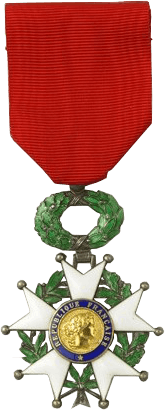
Knight Cross of the Légion d'honneur
-
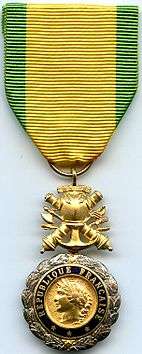
Médaille militaire
-

Croix de Guerre 1914-1918 with 9 palms
-

Croix de Guerre 1939-1945 with 3 palms
-

Portuguese Order of the Tower and Sword
-

U.S. Army Presidential Unit Citation RHINE-BAVARIAN ALPS
-

Fourragère with colors of the Légion d'honneur
-

Fourragère with colors of the Médaille militaire
-
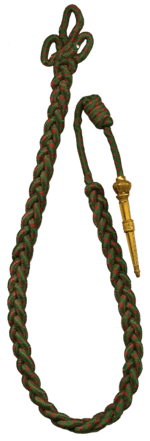
Fourragère with colors of the Croix de guerre 1914-1918
Honours
Battle Honours
- Camerone 1863
- Artois 1915
- Champagne 1915
- Bataille de la Somme 1916
- Les Monts-Verdun 1917
- Picardie-Soissonnais 1918
- Vauxaillon 1918
Regimental Commanders
|
Period 1914-1915 2nd Marching Regiment of the 1st Foreign Regiment
3rd Marching Regiment of the 1st Foreign Regiment
4th Marching Regiment of the 1st Foreign Regiment
2nd Marching Regiment of the 2nd Foreign Regiment
|
Period 1915-1920 : Marching Regiment of the Foreign Legion
Period 1920 -1943 : 3rd Foreign Infantry Regiment Period 1943-1945 : Marching Regiment of the Foreign Legion
Période 1945–present : 3rd Foreign Infantry Regiment |
Honorary Regimental Arms Celebration
The R.M.L.E, was decorated for piercing the Hindenburg Line on September 14, 1918. This battle is celebrated since each year by the 3rd Foreign Infantry Regiment, 3e R.E.I, regiment having inherited the traditions of the R.M.L.E
Marching Regiments of the Foreign Legion- Gallery
Marching Regiments of the 1st, 2nd Foreign Regiments - (1914-1915) - Gallery
-

Generalissimo
Joseph Joffre in 1914.
Moroccan Division - Gallery
-

Generalissimo
Joseph Joffre
with soldiers of the Moroccan Division in 1915. -

Regimental Colors of the 4th Tunisian Tirailleurs Regiment in 1917.
-

Marshal of France Ferdinand Foch in 1918.
Notable Officers and legionnaires
- Colonel Alphonse Van Hecke, Sous-Lieutenant in the R.M.L..E in 1917, who commanded the 7th African Chasseur Regiment (French: 7e régiment de chasseurs d'Afrique, 7e R.C.A) during World War II.
- American poet Alan Seeger.
- Swiss poet, French naturalized Blaise Cendrars.
- Lieutenant Colonel Prince Count Aage of Rosenborg.
- Colonel Paul-Frédéric Rollet.
- Italian writer, Curzio Malaparte
- Italian, French naturalized Lazare Ponticelli
See also
- Paris Fire Brigade
- 3rd Algerian Infantry Division
- Canadian National Vimy Memorial
- List of French paratrooper units
References
Bibliographies:
- Régiment de marche de la légion, Erwan Bergot, éditions Presses de la Cité, 1984. ISBN 2-7242-2440-X.
- Le livre d’or de la Légion étrangère (1831-1955), Jean Brunon et Georges Manue, éditions Charles Lavauzelle et Cie, 1958.
External links
- "Presentation of 3e REI"
- "Detailed History of the RMLE"
- "The French Foreign Legion on the front of Champagne (1914 - 1917)"
- "Regiment's decorations"
